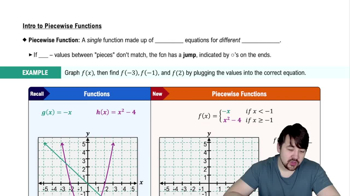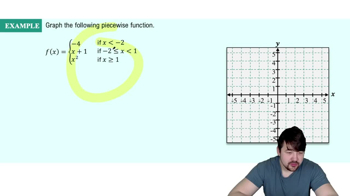Table of contents
- 0. Functions7h 52m
- Introduction to Functions16m
- Piecewise Functions10m
- Properties of Functions9m
- Common Functions1h 8m
- Transformations5m
- Combining Functions27m
- Exponent rules32m
- Exponential Functions28m
- Logarithmic Functions24m
- Properties of Logarithms34m
- Exponential & Logarithmic Equations35m
- Introduction to Trigonometric Functions38m
- Graphs of Trigonometric Functions44m
- Trigonometric Identities47m
- Inverse Trigonometric Functions48m
- 1. Limits and Continuity2h 2m
- 2. Intro to Derivatives1h 33m
- 3. Techniques of Differentiation3h 18m
- 4. Applications of Derivatives2h 38m
- 5. Graphical Applications of Derivatives6h 2m
- 6. Derivatives of Inverse, Exponential, & Logarithmic Functions2h 37m
- 7. Antiderivatives & Indefinite Integrals1h 26m
- 8. Definite Integrals4h 44m
- 9. Graphical Applications of Integrals2h 27m
- 10. Physics Applications of Integrals 2h 22m
0. Functions
Piecewise Functions
Problem 30
Textbook Question
Graphing functions Sketch a graph of each function.
ƒ(x) = { 2x if x ≤ 1 , 3-x if x > 1
 Verified step by step guidance
Verified step by step guidance1
Identify the type of function: This is a piecewise function, which means it is defined by different expressions depending on the value of x.
Determine the domain for each piece: The function is defined as f(x) = 2x for x ≤ 1 and f(x) = 3 - x for x > 1.
Sketch the first piece: For f(x) = 2x when x ≤ 1, this is a linear function with a slope of 2. Plot the line starting from x = -∞ to x = 1, including the point (1, 2) as a solid dot since x = 1 is included.
Sketch the second piece: For f(x) = 3 - x when x > 1, this is also a linear function with a slope of -1. Plot the line starting just after x = 1, with an open circle at (1, 2) since x = 1 is not included in this piece, and continue to x = ∞.
Combine the pieces: Ensure the graph is continuous at x = 1 by checking the values of both pieces at this point. The first piece ends at (1, 2) and the second piece starts just after (1, 2), so the graph is not continuous at x = 1.
 Verified video answer for a similar problem:
Verified video answer for a similar problem:This video solution was recommended by our tutors as helpful for the problem above
Video duration:
6mPlay a video:
Was this helpful?
Key Concepts
Here are the essential concepts you must grasp in order to answer the question correctly.
Piecewise Functions
A piecewise function is defined by different expressions based on the input value. In this case, the function ƒ(x) has two distinct rules: 2x for x values less than or equal to 1, and 3-x for x values greater than 1. Understanding how to evaluate and graph each piece separately is crucial for accurately representing the overall function.
Recommended video:

Piecewise Functions
Graphing Techniques
Graphing techniques involve plotting points and understanding the behavior of functions across their domains. For piecewise functions, it is important to identify the points where the function changes its rule, and to ensure continuity or discontinuity at those points. This includes determining the endpoints and whether they are included in the graph.
Recommended video:

Graphing The Derivative
Continuity and Discontinuity
Continuity refers to a function being unbroken at a point, meaning the function's value at that point matches the limit as it approaches from either side. In the case of the given piecewise function, checking continuity at x = 1 is essential, as it determines whether the graph has a jump or is smooth at that transition point.
Recommended video:

Intro to Continuity
Related Videos
Related Practice




